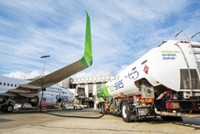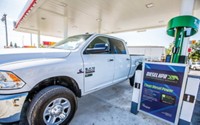Advertisement
Grab your lab coat. Let's get started
Welcome!
Welcome!
Create an account below to get 6 C&EN articles per month, receive newsletters and more - all free.
It seems this is your first time logging in online. Please enter the following information to continue.
As an ACS member you automatically get access to this site. All we need is few more details to create your reading experience.
Not you? Sign in with a different account.
Not you? Sign in with a different account.
ERROR 1
ERROR 1
ERROR 2
ERROR 2
ERROR 2
ERROR 2
ERROR 2
Password and Confirm password must match.
If you have an ACS member number, please enter it here so we can link this account to your membership. (optional)
ERROR 2
ACS values your privacy. By submitting your information, you are gaining access to C&EN and subscribing to our weekly newsletter. We use the information you provide to make your reading experience better, and we will never sell your data to third party members.
Environment
Alternative Jet Fuels Cut Particulate Emissions
Air Pollution: Petroleum substitute could improve air quality at airports
by Kathleen O’Neil
November 11, 2011

Because of planes’ emissions, large airports are important sources of local air pollution, including fine particulate matter, which can increase people’s risk of heart disease and asthma. Now a study has found that particulate matter emissions from a plane’s engine can fall by almost 40% when researchers blend jet fuel with alternative fuels (Environ. Sci. Technol., DOI: 10.1021/es201902e).
The study tested two types of alternative fuels: biofuels made from animal fat or vegetable oils, and fuels made with the Fischer-Tropsch process, which creates liquid hydrocarbons from coal, natural gas, or biomass. The alternative fuels contain very little sulfur or aromatic compounds, both of which create particulates when burned.
The researchers, led by Prem Lobo, of the Missouri University of Science and Technology, tested the fuels in a jet engine of the same model used in Boeing 737s. Using equipment that captures and measures exhaust, they studied emissions while the engine power was set to 7, 30, 85, and 100% to simulate the engine’s performance during an airplane’s taxi, descent to the airport, climb, and takeoff, respectively.
When the researchers blended the alternative fuels with jet fuel, they found that the more alternative fuel they included in a mixture, the lower its particulate emissions. However, the only fuel that provided adequate power for commercial or military use was a 50-50 blend of Fischer-Tropsch fuel and jet fuel. It reduced particulate matter mass in the emissions by 39% compared to jet fuel. The Air Force, which would like to reduce its reliance on imported oil, has approved the fuel blend for use in 99% of its airplanes.
James T. Bartis, a senior policy researcher at the RAND Corporation, was not surprised by the study’s findings since jet fuels are among the dirtiest fuels sold. Only fuels used on ships contain more sulfur, he says.
But Fischer-Tropsch fuels cost about 20 times more than jet fuel, and are not available in quantities adequate for commercial use, he says. Biofuels are a little less expensive, but have similar supply problems.
The best way to reduce emissions and create healthier conditions around airports, he says, is to enact regulations requiring lower emissions, and to reduce sulfur content in mainstream fuels. Fuel processers already remove sulfur from similar diesel fuels at a cost of “pennies per gallon,” he says.




Join the conversation
Contact the reporter
Submit a Letter to the Editor for publication
Engage with us on Twitter